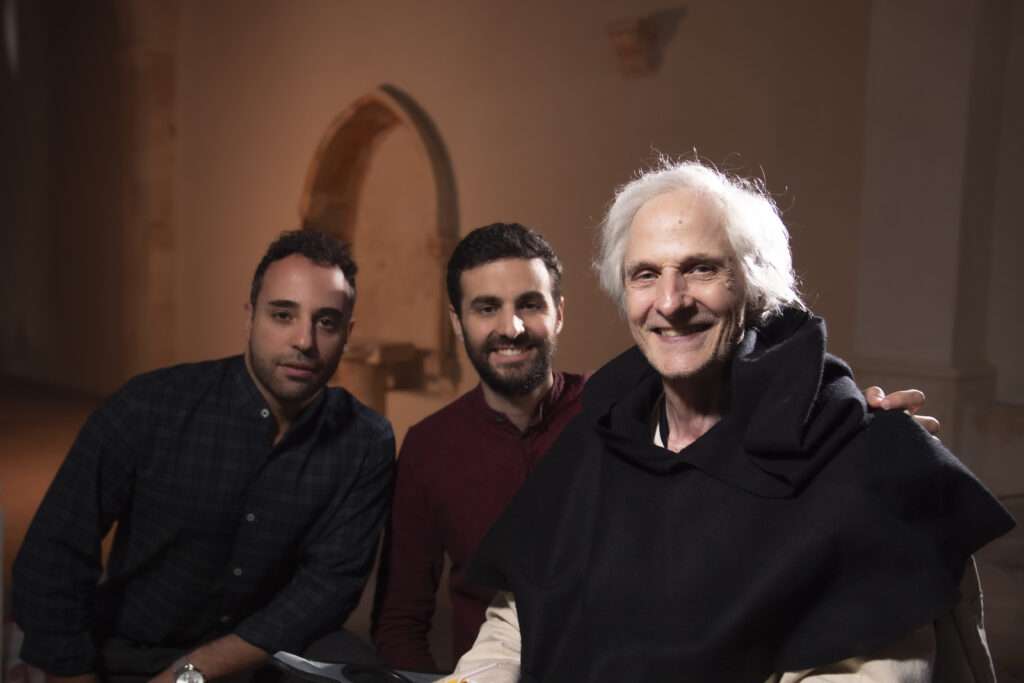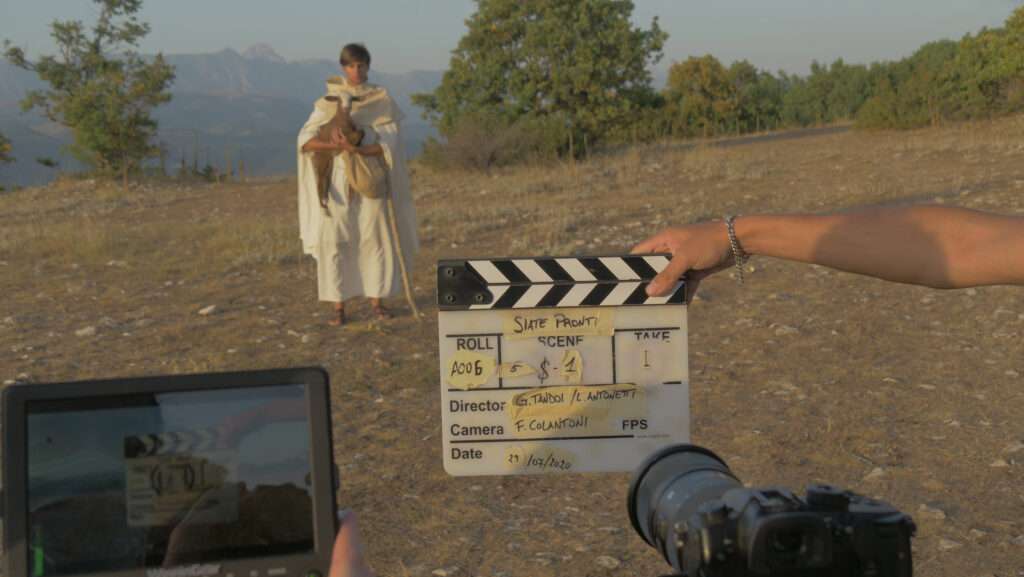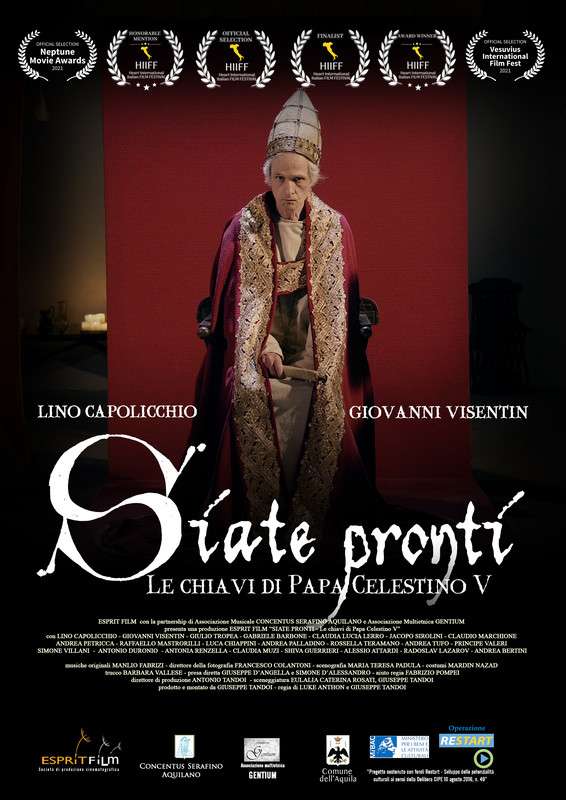
The co-director of the highly documented and compelling historical-philosophical docu-fiction “Be ready – The keys of Pope Celestino V” speaks with us
At Indiecinema Film Festival – Second Edition, two movies selected for the Documentary Competition tell us about the Middle Age, to the delight of Alessandro Barbero or other scholars of the subject. One of these is La Signora Matilde by Diego Schiavo and Marco Melluso, dedicated to Matilde di Canossa and also quite innovative in its form. The other is precisely Be ready – The keys of Pope Celestine V, a 2021 documentary by Luca Anthon and Giuseppe Tandoi, which among other works was yet screened on Monday 12 December 2022 at the Caffè Letterario, in the presence of interpreters Giovanni Visentin (Pope Bonifacio VIII) and Giulio Tropea (Pietro da Morrone at 20 years old).
Get ready – The keys of Pope Celestino V tells the life of the holy eremite Pietro da Morrone, who became Pope in 1294 with the name of Celestino V. He would then go down in history for having renounced the pontificate after only a few months with an official act. The film focuses on the short but intense pontificate, on the famous renunciation and imprisonment imposed by his successor: Bonifacio VIII, in the Fumone prison where a brawl takes place, a struggle between two different conceptions of the Church: the spiritual and the material one. We talked about this and much more with one of the two directors (as well as producer), Giuseppe Tandoi.

The project’s origins and the greatness of a mystic
How did come about your film project which focuses on a historical figure known to the public only in a summary way, as Celestino V a.k.a. Pietro da Morrone?
Pietro / Celestino has been part of our life for many years; his mortal remains reside in the Basilica of Collemaggio in L’Aquila where every year, since 1294, the “Perdonanza” is celebrated, as the first true Jubilee of Christianity. Living in L’Aquila we have approached, over time, this great figure, discovering the teaching drawn from the words reported by the witnesses of the time, those mentioned in the process of canonization, carried out a few years after the death of Pietro himself. More than 300 witnesses who had met, listened to and received healings from him were interviewed. In the Middle Age Pietro was well known and revered, precisely because of the many miracles that occurred thanks to his intercession. Our intent was to bring to light his greatness and his teachings, after so many centuries of Damnatio Memoriae. The “Be ready” is actually a sort of sequel to another docu fiction we made in 2013, the one called “Nolite timere“, in which the story of this forgotten saint had already been addressed, above all rediscovering his life and works which occurred before his election as Pope. In “Be ready” the time had come to face the difficult period of the papacy, his resignation and the final one of the clash with his successor Bonifacio VIII.
In the way of telling the story, one gets the impression that you want to highlight, on several occasions, the clear gap between idealism and political opportunism, between spirituality and materialism, between honesty and corruption. So did this need guide you in structuring and problematizing the documentary?
The life lived by Celestino that has come down to us, if well understood and interpreted, reveals the continuous struggle of this extraordinary man for a true spiritual life, made up of honesty, sincere prayer and trust in divine help. All qualities of which today’s humanity, as well as that of yesterday, is lacking. It is man’s spiritual involution that the fear of not being supported, of not making it alone. And from this fear selfishness, deceit, corruption inevitably flow… in every age. One of Pietro’s tasks was to demonstrate, with his daily example, that living in a healthy and evolved materiality is possible as well as indispensable for true well-being. Divine help was never lacking in his life, so much so that he managed to create and grow a monastic order with more than 300 monks and more than thirty monasteries which, after his election as pope, increased and spread throughout the whole Europe. Combining spirit and matter is feasible, it is not utopia, rather it is our purpose on this Earth. This was Celestino’s intent during his existence; this was the beacon we followed in structuring our work.

The historical sources
Both as regards the period in which the character became known in the Chronicles, and as regards his religious formation and even childhood, which historical sources and advice did you rely on?
The main author of the texts and of the historical research is the screenwriter Eulalia Caterina Rosati, who has studied Pietro’s life for years and has analyzed many biographies written on Celestino, both ancient and recent. The main work from which we have drawn, however, is that of the Celestinian abbot Don Lelio Marini, who in 1600 accurately reread all the ancient writings on Celestino to restore prestige to a figure who had already been forgotten in his time. The title of his work is “Vita et miracoli di San Pietro del Morrone Celestino Papa V“. The author gives much prominence to the many testimonies of the canonization process and faithfully reports the words, both the reproaches and the advice, which Pietro referred to those who turned to him in search of healing. Our goal was to conform to those testimonies, to Pietro’s true words, trying to fictionalize as little as possible.
We particularly appreciated the research carried out on the costumes and locations of the film, which we believe are mainly from Abruzzo. What can you tell us about it?
The merit of the beauty and precision of the costumes goes to the costume designer Mardin Nazad. In that period it was not easy to find clothes already made at the companies in Rome that rent them, because they were all out of other productions in progress. Some of us were forced to buy them, others to have them sewn by a seamstress.
As for the locations, Abruzzo offers enchanting places, natural landscapes and well-preserved medieval churches. Together with the set designer Maria Teresa Padula we directors made several site inspections before finding the most suitable locations also from an organizational point of view. Great support was given to us by the Municipality of Navelli where we set the scenes in the abandoned town, the meeting with the abbot and most of the interiors in the church of Santa Maria in Cerulis, where we even created the Fumone prison cell. The first hermitage of Pietro was instead staged in the Eremo di San Michele near Bominaco, a fraction of the municipality of Caporciano (AQ); an exceptional place, where you breathe deep spirituality and true peace.

A docu-fiction capable of turning into horror
Even the docu-fiction component has positively impressed us. Among the fictional scenes that dramatize Pietro’s journey, those of the diabolical temptation in the cave are, for example, of considerable effect. Did you also cling to some parallel passion for genres as horror to make them?
A passion that we directors have in common is for the fantasy genre which often approaches the tones and themes of horror. The lives of saints are often studded with incredible events, “paranormal” we would say today. Pietro’s life was filled with manifestations of the divine: apparitions of angels, contributions of food and drink, the ringing of invisible bells… but in addition to the divine, dark presences often manifested themselves in order to hinder the work of the saint. From an early age Pietro had to fight against attacks from the evil one which occurred both indirectly, through involved people, and directly with invisible aggressions so strong that they became physical. One day his hermitage was set on fire by the devil, but Pietro was not afraid, he did not flee, he continued to pray and the flames disappeared instantly as if they were only an illusion…

Very good performers,one name above all: Lino Capolicchio
Remarkable also, both in terms of number and quality, the cast you put together. How did you go about recruiting interpreters? Is there some particular episode to tell here too?
We had already worked with many actors in the cast in the past, such as with the very good Claudia Lerro or with Claudio Marchione, while for the young people the casting had to be carried out remotely due to the restrictions due to Covid. The co-star Giovanni Visentin was introduced to me by the set designer who had already worked with him and it was an honor for us to be able to work with him, with a great talented actor who beautifully rendered a difficult and unpleasant character like that of Bonifacio VIII, making him almost likeable at times.
As for the recently passed maestro Lino Capolicchio, I had had the opportunity to know him and work with him already in 2013, when he played Celestino V for the first time in our previous work. It’s not easy to define a great actor like him, it’s not easy to find the right words. “Be ready” was his last film, and we had understood this well because he had been suffering from a serious illness for years and it had become difficult for him to work. When we spoke again he assured us he was fine, but two days before shooting he had a sudden relapse, mistaken for a temporary malaise. Although he was physically in terrible shape, so much so that in those days he could neither eat nor sleep, Lino wanted to shoot at all costs, sure that the next day would be better. With great difficulty and shooting quickly to avoid tiring him, we managed to bring the film home in five days. His presence was truly an immeasurable gift. From the filming, his state of poor health is not revealed at all. Indeed, when he recited, all physical pain disappeared. He managed to awaken an extraordinary strength within himself. We will always be grateful for this last sacrifice of his. And we are also grateful to his wife, Francesca, who was with us on set in those days to support and comfort him. It wasn’t easy for him to fight with the body that was slowly abandoning him. His willpower worked a real miracle.

Something about Music
Music plays an important role in recreating similar atmospheres. How did this soundtrack come about?
The soundtrack is thanks to the experience and sensitivity of Maestro Manlio Fabrizi and the vocal and instrumental group he directs, the Concentus Serafino Aquilano, with whom he has been creating pieces of exquisite workmanship for years, dealing with sacred and spiritual themes. The Maestro took his cue from ancient works to then follow his inspiration and thus generate unpublished pieces, both sung and purely music, which blend well with Celestino’s life and his mission.
Finally, in addition to festival participations such as the one by Indiecinema, what circulation is your documentary having so far?
The film has already aired on TV2000 and is currently available for rental or purchase on the Vimeo platform. Various screenings were also organized in the schools of L’Aquila. Hopefully in the future we will be able to sell it to other national and non-national TVs.




